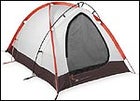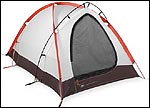For four-season use, you’re looking at upper-end tents. So for obvious reasons—more poles, more materials—prices are higher than the lighter-weight models. But several tents should work well for you. One good choice is REI’s Mountain 2 Tent ($249; www.rei.com), an elongated dome-style shelter. Two doors and a big vestibule make it convenient for getting in and out and storing stuff, while REI has borrowed and modified several design features from “big-name” tentmakers to produce a tent that’s sturdy yet reasonably light at seven pounds ten ounces.
 Mountain 2
Mountain 2
Eureka’s Alpenlite XT2 is another very solid tent at $300 (www.eurekacamping.com), which isn’t too steep a price (at some outdoor-gear sites you can find last year’s model for $209 or less). It’s a true four-season tent, with an extremely rugged A-frame design and an all-around fly that goes right down to the ground. So when buttoned up, it’ll shed snow, wind, and rain like a rock. The weight is a restrained seven pounds seven ounces. It’s even freestanding, although of course you’ll want to stake it out to ensure it doesn’t fly to Oz during a stiff winter storm.
From there, prices go up pretty briskly. Kelty’s Orb 2 is a tough mountaineering/winter tent that sells for $350 (www.kelty.com). In the same price range you’ll find Exped’s well-made Sirius ($350; www.exped.com), which has a very aerodynamic tunnel design. And there’s Sierra Designs’ Stretch Dome AST, a classic design in a four-season tent that has a price tag of $470 (www.sierradesigns.com).
More tents reviewed in ���ϳԹ���‘s .


